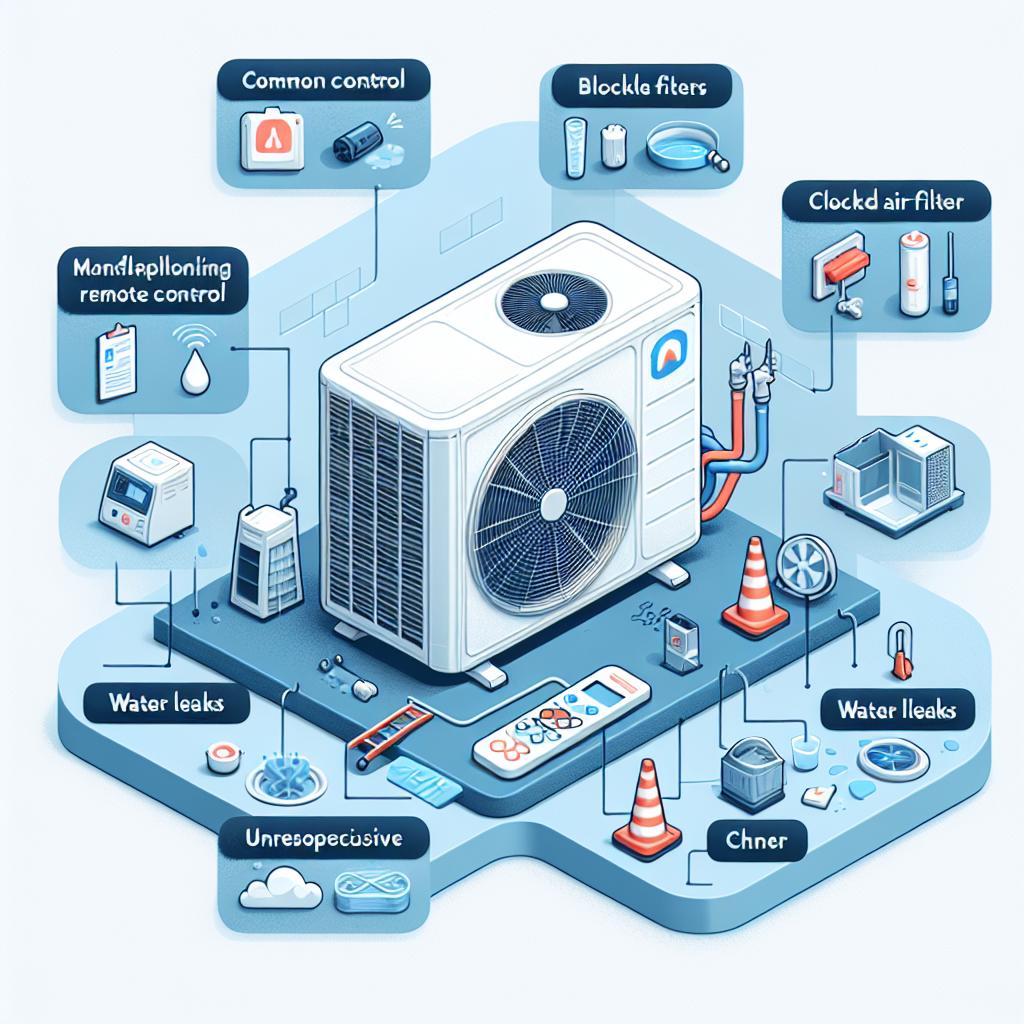As the summer sun blazes overhead and your garage transforms into an oven, the need for a cool, comfortable workspace becomes undeniably clear. Whether you use your garage as a personal workshop, a storage haven, or just a place to park your car, the heat can quickly turn it from a functional area into an unbearable retreat. Enter the mini split air conditioning system—an efficient, space-saving solution that promises to breathe new life into your garage environment. In this comprehensive guide, we’ll walk you through the process of installing a mini split AC unit, from the preliminary planning stages to the final touches, ensuring that you’re equipped with the knowledge to make your garage a refreshing sanctuary all year round. Get ready to transform your space and enjoy the comfort that comes with a cool breeze, tailored just for you.
Selecting the Right Mini Split AC Unit for Your Garage Space
When it comes to choosing the perfect mini split AC unit for your garage, several key factors should guide your decision to ensure optimal comfort and efficiency. First, consider the size of your garage. A unit that is too small won’t adequately cool the space, while one that is too large may cycle on and off too frequently, leading to higher energy costs and less consistent cooling. Refer to the British Thermal Units (BTUs) needed based on your garage’s square footage to find a well-matched unit. Second, evaluate the insulation quality of your garage. If it’s poorly insulated, you might require a more powerful unit to combat temperature fluctuations effectively.
Additionally, think about the specific conditions of your garage. If you use it as a workspace, you may need features like a dehumidification function. Here’s a brief checklist of considerations:
- BTU Rating: Match to square footage.
- Energy Efficiency Ratio (EER): Choose higher ratings for better efficiency.
- Installation Type: Decide between wall-mounted or floor-mounted options.
- Multi-zoning Capability: Useful if dividing the garage into sections.
- Noise Levels: Opt for quieter models if sound is a concern.
To illustrate the importance of BTU ratings, consider the following table that summarizes the recommended BTUs based on garage sizes:
| Garage Size (sq. ft.) | Recommended BTU Rating |
|---|---|
| 150 – 250 | 6,000 – 7,000 |
| 250 - 350 | 8,000 – 9,000 |
| 350 – 450 | 9,000 – 12,000 |
| 450 – 600 | 12,000 – 15,000 |

Essential Tools and Materials for a Successful Installation
Embarking on the journey of installing a mini-split AC in your garage requires an arsenal of essential tools and materials to ensure a smooth and efficient process. Gathering these items beforehand will save you time and prevent unnecessary trips to the hardware store. Here’s a list of essentials to have on hand:
- Drill and Drill Bits: For mounting the indoor and outdoor units securely.
- Level: To ensure that your units are mounted perfectly horizontal.
- Measuring Tape: For precise measurements to adhere to manufacturer specifications.
- Pipe Wrench: For tightening refrigerant lines.
- Tubing Cutter: To neatly cut the copper pipes.
- Screwdrivers (Flathead and Phillips): Essential for securing different components.
In addition to the tools, having the right materials at your disposal is crucial for a successful installation. Here’s a quick look at what you’ll need:
| Material | Description |
|---|---|
| Copper Refrigerant Lines | A vital component for transferring refrigerant between the indoor and outdoor units. |
| Insulation Tape | Use it to wrap the refrigerant lines to prevent condensation. |
| Drain Hose | To ensure proper drainage from the indoor unit. |
| Mounting Hardware | Includes brackets, anchors, and screws to secure the units. |

Step-by-Step Installation Process for Optimal Performance
To achieve the best results from your mini split AC installation, begin by selecting the ideal location for both the indoor and outdoor units. Ensure that the indoor unit is placed where it can effectively circulate air throughout the garage. Ideally, mount the unit high on the wall, away from obstructions, to facilitate optimal airflow. For the outdoor unit, choose a spot that is both level and well-ventilated, exposing it to the ambient environment without risking damage from elements or debris. Make sure to address any surfaces or areas around the units that may require reinforcements or clearances, such as minimum distance from walls and clear access for maintenance.
Once the locations are set, gather all necessary tools and materials before beginning the actual installation. This includes:
- Drill and drill bits
- Line set (refrigerant lines)
- Electrical wiring
- Mounting brackets
- Insulation tape
Next, establish a route for the refrigerant lines and electrical cables. Use a conduit to protect the wires and insulate the line set to maintain efficiency. Once everything is in position, follow the manufacturer’s instructions for connecting the indoor and outdoor units, making sure to check for any leaks or obstructions in the system. Adhering to these steps will ensure a seamless installation process and pave the way for the mini split AC to perform at its peak efficiency.

Common Challenges and Troubleshooting Tips for Mini Split Systems
Installing a mini-split system can transform your garage into a comfortable space, but several common challenges may arise during operation. Frequent issues include inadequate cooling or heating, strange noises, and improper drainage. To overcome inadequate climate control, ensure that the unit is appropriately sized for the space. In some cases, adjusting the temperature settings or cleaning the filters may resolve the issue. If you hear unusual sounds, such as rattling or hissing, they might indicate loose components or refrigerant leaks. Regular maintenance checks can help in identifying and addressing these problems before they escalate.
Another common challenge is the proper drainage of condensate. If water is pooling around your indoor unit, it might be due to clogged drain lines or improper installation. Regularly inspect the drain line for blockages and ensure it’s positioned correctly to facilitate drainage. Here’s a quick reference table to help diagnose some typical issues and their solutions:
| Issue | Possible Solution |
|---|---|
| Inadequate Cooling/Heating | Check unit size and clean filters |
| Strange Noises | Inspect for loose parts or refrigerant leaks |
| Water Leakage | Clear drain line and verify installation |
| Inefficient Operation | Set temperature correctly and perform maintenance |
Q&A
Q&A: A Comprehensive Guide to Installing a Mini Split AC in a Garage
Q1: What is a mini split AC system, and why should I consider installing one in my garage?
A1: A mini split AC system is a ductless air conditioning solution that consists of an outdoor compressor unit and one or more indoor air-handling units. It’s a great option for garages because it offers efficient cooling without the need for ductwork. This makes it ideal for spaces that are not connected to your home’s central HVAC system, allowing you to enjoy a comfortable environment for hobbies, workouts, or as a workspace, especially during the hot summer months.
Q2: Are there any specific garage conditions that might affect the installation of a mini split AC?
A2: Yes, several factors can influence your installation process, including the size and insulation of your garage, local climate conditions, and the position of the garage relative to your home. A well-insulated garage will require a smaller unit, while larger, less insulated spaces may necessitate a more robust system. Additionally, garages with windows or doors that frequently open may benefit from a unit with higher cooling capacity.
Q3: What tools and materials are necessary for installing a mini split AC in my garage?
A3: To install your mini split AC, you’ll typically need a few basic tools: a drill, level, stud finder, wrenches, screwdrivers, and a vacuum pump. Materials may include mounting brackets, insulation for the refrigerant lines, electrical wiring, and any ducting if needed for airflow. It’s advisable to check the manufacturer’s installation instructions for any specific tools or materials you might need.
Q4: Is it possible to install a mini split AC by myself, or should I hire a professional?
A4: While it is possible to install a mini split AC as a DIY project, it may require a fair amount of technical knowledge, especially in electrical and refrigerant line installation. If you have experience with HVAC systems and are comfortable working with electrical components, you might take on the project yourself. However, hiring a licensed professional is highly recommended to ensure the installation meets local building codes and operates efficiently. A proper installation can also protect your warranty coverage.
Q5: What steps should I follow for a successful installation?
A5: The installation process generally involves several key steps:
- Choose the right location for the indoor and outdoor units that provides optimal airflow and minimizes external obstructions.
- Mount the indoor unit using brackets and ensure it’s level.
- Install the outdoor unit securely on a solid base, raising it off the ground to avoid flooding.
- Connect the refrigerant lines and electrical connections according to the manufacturer’s specific guidelines.
- Seal the hole where the lines pass through the wall to prevent air and moisture ingress.
- Vacuum the lines to remove any air and moisture before charging the system with refrigerant.
- Test the system for proper operation once everything is connected.
Q6: How do I maintain my mini split AC after installation?
A6: Regular maintenance is key to ensuring your mini split AC operates efficiently. This includes cleaning or replacing the air filters every one to three months, checking the outdoor unit for debris, and ensuring the drainage lines are clear. Scheduling professional maintenance at least once a year can help identify potential issues early and keep your system running smoothly.
Q7: What other benefits can I expect from installing a mini split AC in my garage?
A7: Beyond improved comfort, a mini split AC can enhance the usability of your garage, making it a more pleasant space for various activities. An air-conditioned garage can help protect tools and equipment from heat and humidity, reducing potential damage. Additionally, by regulating the temperature, you can create a more conducive environment for work or hobbies, which can lead to increased productivity and enjoyment.
With this guide, you’re well-equipped to consider, plan, and potentially embark on the installation of a mini split AC in your garage. Whether you opt for a DIY approach or you enlist the help of professionals, you’re taking a significant step toward maximizing your garage’s comfort and functionality!
In Summary
As we conclude our comprehensive guide to installing a mini split AC in your garage, we hope you feel equipped to transform your space into a comfortable retreat, regardless of the weather outside. With careful planning, the right tools, and a bit of patience, you can successfully create an environment that enhances productivity, protects your belongings, or simply serves as a cool escape during the summer months.
Remember that this investment not only boosts the usability of your garage but also adds value to your home. Whether you’re tinkering with tools, pursuing hobbies, or just seeking a tranquil spot, the benefits of a mini split AC system are clear. Take your newfound knowledge, breathe life into your garage, and enjoy the comfort that comes from a climate-controlled environment.
Thank you for joining us on this journey towards achieving a cooler, more enjoyable garage space. Here’s to many good times ahead in your newly transformed haven!

